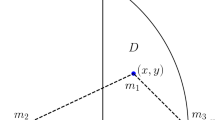Abstract
We performed numerical orbit integrations of the equal-mass free-fall three-body problem. We provided numerical evidence of the existence of triple collision orbits concentrating on the shape of triangles formed by the three bodies. In the process, in the negative side, we confirmed that the shape of the triangle of non-triple collision orbits deviates from equilateral as the orbit approaches the instant of supposed triple collision. In the positive side, the orbit integrations have been done along the three binary collision curves on which the orbit perform binary collision. These curves meet at the triple collision point (TCP). Three binary collisions have the three base edges, whose direction defines the edges of the triple collision orbit. The triangle defined by these three edges precisely coincides with the equilateral triangles of the triple collision orbit.








Similar content being viewed by others
Notes
This is the slingshot effect that the third boy is accelerated or decelerated when it passes through between the remaining two bodies
References
Devaney, Robert L.: Triple collision in the planar isosceles three body problem. Invent. Math. 60, 249–267 (1980)
McGehee, R.: Triple collision in the collinear three-body problem. Invent. Math. 27, 191–227 (1974)
Mikkola, S., Tanikawa, K.: Algorithmic regularization of the few-body problem Mon. Not. R. Astron. Soc. 310, 745–749 (1999)
Mikkola, S., Tanikawa, K.: Implementation of an efficient logarithmic-Hamiltonian three-body code. New Astron. 20, 38–41 (2013)
Moeckel, R.: Chaotic dynamics near triple collision. Arch. Rat. Mech. 107, 37–68 (1989)
Montgomery, R.: The zero angular momentum three-body problem: all but one solution has syzygies. Ergod. Theor. Dyn. Syst. 27, 1933–1946 (2007)
Simó, C., Martinez, R.: Qualitative study of the planar isosceles three-body problem. Celest. Mech. 41, 179–251 (1988)
Tanikawa, Mikkola: Symbol sequences and orbits of the free-fall three-body problem. Publ. Astron. Soc. Japan 67(6), 10 (2015)
Tanikawa, K., Saito, M.M., Mikkola, S.: (Paper I) A search for triple collision orbits inside the domain of the free-fall three-body problem. Cel. Mech. Dyn. Astron. 131, 24 (2019)
Xia, Zhihong: The existence of noncollision singularities in Newtonian systems. Annals Math. 135, 411–468 (1992)
Author information
Authors and Affiliations
Corresponding author
Additional information
Publisher's Note
Springer Nature remains neutral with regard to jurisdictional claims in published maps and institutional affiliations.
Rights and permissions
About this article
Cite this article
Tanikawa, K., Mikkola, S. Numerical confirmation of the existence of triple collision orbits inside the domain of the free-fall three-body problem. Celest Mech Dyn Astr 133, 52 (2021). https://doi.org/10.1007/s10569-021-10050-8
Received:
Revised:
Accepted:
Published:
DOI: https://doi.org/10.1007/s10569-021-10050-8




